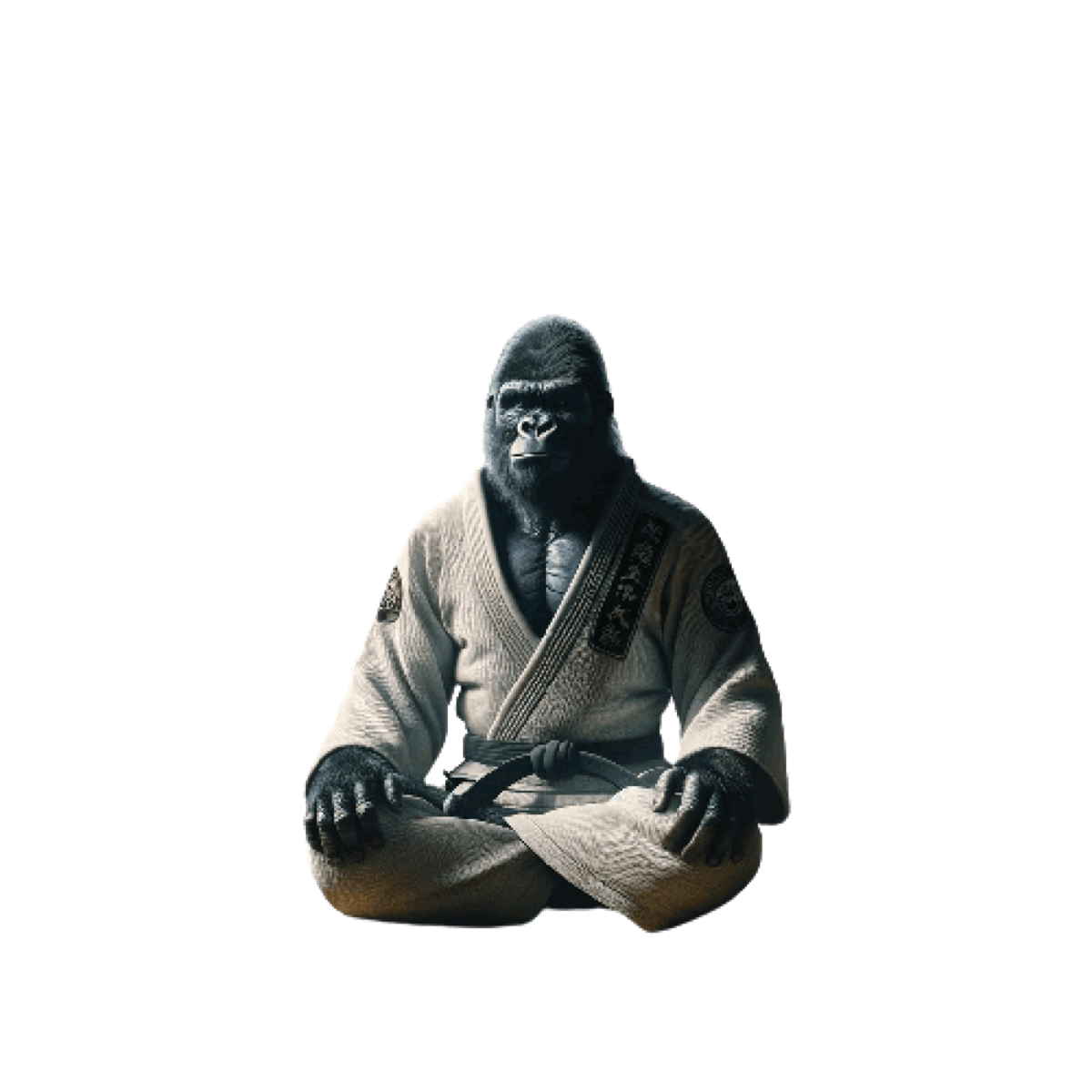Menu
Close
Essential BJJ techniques
Uncover the intricacies of BJJ techniques with our comprehensive guide. From basic moves to complex maneuvers, our step-by-step tutorials, images, and videos will enhance your BJJ journey.
Welcome to our comprehensive guide to BJJ techniques. This essential resource will serve as your roadmap, guiding you through the complex and fascinating world of BJJ manoeuvres. Whether you’re a novice practitioner stepping onto the mat for the first time or an experienced grappler looking to refine your skills, we’ve got you covered.
Understanding and mastering BJJ techniques are crucial to your progress and effectiveness in this dynamic martial art. Prepare to dive deep into the intricacies of this art form, from fundamental positions and submissions to advanced sweeps and transitions.
So, tighten your gi, tie your belt, and embark on this enriching journey of BJJ techniques together.

Understanding BJJ techniques
Brazilian Jiu-Jitsu is more than just a physical sport; it’s a chess match played on the mat. Success in BJJ is deeply rooted in understanding and executing techniques with precision. This section is designed to provide an overview of the importance of mastering these techniques and the principles that guide them.
The importance of mastering techniques in BJJ
The cornerstone of progress in BJJ is the mastery of its diverse techniques.
Knowing many moves is less beneficial than truly mastering a smaller set. When you master a technique, you can execute it effectively under the high-stress conditions of sparring or competition.
Furthermore, the confidence gained from this mastery can significantly improve your overall performance.
Remember, in BJJ. It’s not just about strength or speed; technique is the key to achieving superior control and leverage over your opponent.
The fundamental principles of BJJ techniques
Brazilian Jiu-Jitsu techniques revolve around key principles that dictate the flow of a match. These principles involve managing distance, maintaining control, applying pressure, and executing submissions.
- Managing Distance: The key to controlling a match is managing the distance between you and your opponent. Good distance management can help you defend against attacks and set up your own.
- Maintaining Control: This principle is about positioning yourself to maximise your control over your opponent, typically by securing dominant positions.
- Applying Pressure: Pressure on your opponent wears them down physically and mentally, forcing them to make mistakes that you can exploit.
- Executing Submissions: This is the culmination of all the other principles. Once you’ve managed the distance, maintained control, and applied pressure, you can execute a submission to end the match.
Mastering BJJ techniques involves understanding and applying these principles strategically throughout a match. Every technique you learn will incorporate these principles to some degree. Understanding this will provide a solid foundation for learning and mastering the varied techniques of Brazilian Jiu-Jitsu.
Basic BJJ techniques for beginners
Brazilian Jiu-Jitsu is a journey of continuous learning and refinement. For beginners, this journey starts with understanding and practising the fundamental techniques. These include basic positions, submissions, sweeps, and transitions. Grasping these fundamental techniques will help you defend yourself effectively and lay a solid foundation for more advanced moves.
Fundamental positions (guard, side control, mount)
Brazilian Jiu-Jitsu is often defined by its positional hierarchy. Understanding this hierarchy and its fundamental positions is key to BJJ’s success.
Guard
The guard is a defensive position where you’re on your back, using your legs to control your opponent. It allows for various sweeps and submissions while offering good protection.
Side control
This dominant position sees you controlling your opponent while lying perpendicular to them. It’s a strategic position with various options for transitions and submissions.
Mount
The mount is a highly dominant position where you sit atop your opponent’s torso. From here, you can launch many attacks while maintaining strong control.
Basic submissions (rear naked choke, armbar, triangle)
Submissions are the final goal in Brazilian Jiu-Jitsu, where you compel your opponent to surrender. As a beginner, it’s essential to understand these basic submissions:
Rear-naked choke
This chokehold is applied from an opponent’s back. It’s highly effective and often used in both competitive and self-defence scenarios.
Armbar
The armbar is a classic submission that involves isolating an opponent’s arm and applying pressure on their elbow. It can be executed from various positions.
Triangle choke
Executed from the guard, the triangle choke involves trapping the opponent’s head and one arm inside your legs and applying pressure to their neck.
Essential sweeps and transitions
Sweeps and transitions are fundamental components of the dynamic BJJ game. These movements allow you to reverse positions and navigate towards more dominant ones.
Scissor sweep
This is an essential and highly effective sweep from the guard position. It’s a great way to reverse the situation and end up in a dominant mount position.
Hip escape (shrimping)
Known as “shrimping,” this essential movement technique creates space and escape from various positions.
By understanding and practising these basic BJJ techniques, beginners can rapidly improve their game and prepare for more advanced moves. Remember, Brazilian Jiu-Jitsu is not about speed but patience, precision, and technique.
Intermediate BJJ techniques
As you progress in your Brazilian Jiu-Jitsu journey, you’ll encounter more intricate techniques that build on the fundamentals. This section will cover some intermediate positions, submissions, sweeps, and transitions you’ll encounter as you climb the ranks.
Advanced positions (spider guard, butterfly guard)
As you delve deeper into BJJ, the complexity of positions also increases. Two such intermediate positions are:
Spider guard
The Spider Guard is an advanced guard technique that utilizes the practitioner’s legs and feet to control the opponent’s arms. It offers numerous possibilities for sweeps and submissions while providing excellent control.
Butterfly guard
The Butterfly Guard involves the practitioner being on their back, with their legs on the inside of the opponent’s legs, similar to a butterfly’s wings. It’s a dynamic position with various options for sweeps and submissions.
Complex submissions (kimura, omoplata)
You’ll be introduced to more complex submissions as an intermediate BJJ student. Here are two of them:
Kimura
Named after the legendary judoka Masahiko Kimura, the Kimura lock is a shoulder lock submission technique that can be applied from various positions.
Omoplata
The Omoplata is a shoulder lock submission that uses your legs to trap your opponent’s arm. Though it can be complex to set up, it offers a highly effective submission when executed correctly.
Intricate sweeps and transitions
As your skill level increases, so does the complexity of sweeps and transitions. These moves help to keep the BJJ game fluid and dynamic:
Tornado sweep
A famous sweep among intermediate practitioners involves spinning under your opponent while in guard and using this momentum to flip them over.
Berimbolo
The Berimbolo is a widespread transition from the De La Riva guard, used to invert and spin underneath your opponent, usually aiming to take their back.
These intermediate BJJ techniques require a solid understanding of the fundamentals. Consistent practice and drilling are the keys to mastering these techniques.
Your BJJ journey is a marathon, not a sprint, so take your time to understand and master these intermediate techniques truly.
Advanced BJJ Techniques
As you progress in your Brazilian Jiu-Jitsu journey, you’ll encounter more intricate techniques that build on the fundamentals. This section will cover some intermediate positions, submissions, sweeps, and transitions you’ll encounter as you climb the ranks.
High-level positions (De La Riva, X-guard)
A solid positional game is the cornerstone of any successful BJJ practitioner. These high-level positions can provide you with an extensive toolkit for controlling, sweeping, and submitting your opponent:
De La Riva guard
Named after the legendary Ricardo De La Riva, this guard involves wrapping one leg around your opponent’s leg and hooking their far thigh while your other foot controls their near leg. This position offers a wide range of sweep and submission opportunities.
X-Guard
The X-Guard is an advanced guard where you control your opponent by placing your legs in the shape of an ‘X’ under their thigh and far leg. It’s particularly potent for sweeping standing opponents.
Expert submissions (gogoplata, berimbolo)
Advanced BJJ techniques often involve sophisticated submissions that require a deep understanding of body mechanics:
Gogoplata
This is a complex submission where you apply your shin to pressure your opponent’s throat while you control their posture. It’s typically applied from a guard position.
Berimbolo
While technically more of a transition, the Berimbolo is often used as a setup for back takes and subsequent submissions. It involves inverting and spinning from a De La Riva guard under your opponent.
Advanced sweeps and transitions
Advanced sweeps and transitions are the cornerstones of a fluid, dynamic BJJ game:
Lapel sweeps
These involve innovatively using your opponent’s gi lapel to off-balance and sweep them.
Leg drag transitions
A staple in the modern BJJ game, these involve controlling your opponent’s legs and “dragging” them across to pass their guard.
Remember, advanced BJJ techniques aren’t about complex movements; they’re about understanding the basics to such a degree that you can apply them increasingly sophisticatedly. Practice makes perfect, so keep drilling these techniques and transitions until they become second nature.
Defensive techniques
In BJJ, a well-rounded practitioner is as comfortable defending as they are attacking. These defensive techniques help you neutralise your opponent’s offensive actions and turn their moves to your advantage.
Escapes and reversals
Escaping from an inferior position is a crucial skill in BJJ. Escapes and reversals not only get you out of immediate danger but also often provide opportunities to reverse the situation in your favour:
Mount escape
Also known as the ‘Upa’, this escape leverages a bridge-and-roll technique to flip your opponent over and recover a top position from a mounted position.
Side control escape
You create space using your arms and hips, allowing you to move to a safer position or even reverse the situation to gain control.
Reversals
Reversals are techniques used to turn the tables on your opponent when initiating a move, turning their attack to your advantage.
Defensive posture and guard retention
Defensive posture and guard retention techniques are paramount in preventing your opponent from passing your guard and achieving dominant positions:
Defensive posture
A solid defensive posture minimises your vulnerabilities and maximises your ability to respond to your opponent’s movements. This involves keeping your elbows close to your body, protecting your neck, and using your knees and arms to create barriers against your opponent.
Guard retention
Techniques like the ‘shrimp’ or ‘hip escape’ help retain guard. The objective is to use your hips, legs, and arms effectively to prevent your opponent from passing your guard.
Mastery of defensive techniques requires consistent practice and drilling. These techniques will become instinctual with time, enabling you to react effectively under pressure in sparring or competition.
Offensive strategies and techniques
BJJ emphasises defence; developing an offensive game is equally important. It involves using strategic passes, setting traps, and implementing submission chains to gain an advantage over your opponent.
Passes and attacks
Mastering passing and attacking is a significant aspect of BJJ’s offensive techniques. Here’s an insight into some of these tactics:
Guard passing
In BJJ, guard passing is a fundamental offensive technique. It involves bypassing your opponent’s guard to achieve a more dominant position, such as the side control or mount. Examples include the Torreando Pass, Knee Slice, and Stack Pass.
Attacks from dominant positions
Once you have achieved a dominant position, multiple attack opportunities exist. You can go from Mount or Back Control for submissions like the Armbar, Rear Naked Choke, or Americana.
Setting traps and submission chains
One level higher in offensive strategy involves setting traps and creating submission chains:
Setting traps
Traps in BJJ refer to scenarios where you guide your opponent to make predictable movements, which you then exploit for your advantage. It can be a simple trap like feigning weakness in one area to encourage your opponent’s attack and then capitalising on their committed movement.
Submission chains
A submission chain, also known as a ‘sequence’, is a series of interconnected techniques where the transition from one submission attempt leads directly into another. It’s an effective strategy to keep constant pressure on your opponent and make them tap out.
Offensive strategies and techniques in BJJ are about being proactive, controlling the pace, and forcing your opponent to react to your moves. Understanding these concepts can significantly improve your BJJ game, making you a formidable opponent.
FAQs about BJJ techniques
What are the fundamental BJJ techniques a beginner should learn first?
Starting with the basics like Guard, Side Control, and Mount positions, and simple submissions like Rear Naked Choke and Armbar can form a solid foundation for your BJJ journey.
How often should I practice BJJ techniques to get better?
Consistency is key in BJJ. Practising regularly, three to four times weekly, can lead to noticeable improvements.
How can I safely practice BJJ techniques?
Always warm up properly before starting your practice, and try to learn new techniques under the guidance of a qualified coach. Additionally, practising with a partner who maintains a controlled and respectful pace can ensure safety.
When can I start learning advanced BJJ techniques?
This largely depends on your comfort and proficiency with basic and intermediate techniques. Your coach can guide you on when to start incorporating advanced techniques into your repertoire.
What is the most effective offensive technique in BJJ?
The effectiveness of a technique depends on various factors, such as your opponent’s style, size, skills, and situation during the match. Developing a diverse skill set and adapting to the match dynamics are the most effective.
Understanding and practising various BJJ techniques – basic to advanced, defensive to offensive – are vital to mastering this dynamic martial art. Whether you’re a beginner starting with fundamental positions and submissions or an experienced practitioner honing advanced techniques, remember that consistency and safe practice are your stepping stones to success.
We encourage you to explore these techniques further, refine your skills, and unlock your potential on the mat. If you found this guide helpful, consider subscribing to our newsletter or joining our community to receive more insightful content about BJJ. Stay connected, stay informed, and keep rolling!



